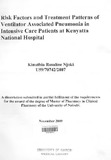| dc.contributor.author | Kinuthia, Rosaline N | |
| dc.date.accessioned | 2013-05-24T07:08:46Z | |
| dc.date.available | 2013-05-24T07:08:46Z | |
| dc.date.issued | 2009 | |
| dc.identifier.citation | Master of Pharmacy in Clinical Pharmacy | en |
| dc.identifier.uri | http://erepository.uonbi.ac.ke:8080/xmlui/handle/123456789/25140 | |
| dc.description.abstract | Background: Ventilator associated pneumonia (VAP) is defined as nosocomial pneumonia in a
patient on mechanical ventilatory support by endotracheal tube or tracheostomy for > 48hours Studies show that VAP affects about eight to 20% of lCU patients and up to 27% of MV
patients.3,5,8 There are identified risk factors associated with VAP?,4,7
The purpose of this study was to determine the extent of infection, risk factors and treatment
patterns of critically ill patients at the Kenyatta National Hospital lCU.
Method: This was a hospital based prospective observational study in all patients admitted in the
intensive care unit of Kenyatta National Hospital and put on mechanical ventilation for ~ 48hrs
in a period of four months from April to July 2009.
These patients were followed up daily for development of YAP. Potential risk factors for YAP
were noted before development of VAP. The antibiotics chosen for treatment of VAP and the
clinical outcome of the patient following treatment were evaluated. The data collected were
analyzed using Statistical Package for Social Sciences (SPSS) software.
Results: Overall, 320 patients were admitted to the lCU for the study period, 139 of these were
mechanically ventilated for ~ 48 hours and only 39 were diagnosed to have YAP.
The incidence of YAP was 12.2% in this population, and 28% in the mechanically ventilated
patients. The mean number of days to development ofVAP was 8.7 ± 0.9.
The commonest bacterial pathogens isolated on tracheal aspirates were Klebsiella (23.1 %),
Citrobacter (12.8%), Staphylococcus aureus (12.8%), Pseudomonas aeruginosa (10.3%) and
Acinetobacter species (10.3%).
The most commonly used class of antibiotics was cephalosporins (53.8%) and the main drug in
this class was ceftriaxone ( 41 %). Meropenem was the main antipseudomonal antibiotic used.
Conclusion: Klebsiella species was the commonest organism isolated. The key drugs used for
the treatment of VAP were ceftriaxone and meropenem.
The commonest modifiable risk factors for VAP were enteral feeds and use of paralytic agents.
Other common risk factors were low GCS, trauma, reintubation and sepsis.
Recommendations
• A further study involving a larger population is proposed to better document these
findings.
• The KNH leu team should be advised to identify patients who have modifiable risk
factors early enough, to better their management.
• A more comprehensive antibiotic use review should be conducted in order to develop a
formulary for treatment of VAP in the institution. | en |
| dc.description.sponsorship | University of Nairobi | en |
| dc.language.iso | en | en |
| dc.title | Risk factors and treatment patterns of ventilator associated pneumonia in intensive care patients at Kenyatta National Hospital | en |
| dc.type | Thesis | en |
| dc.description.department | a
Department of Psychiatry, University of Nairobi, ; bDepartment of Mental Health, School of Medicine,
Moi University, Eldoret, Kenya | |

